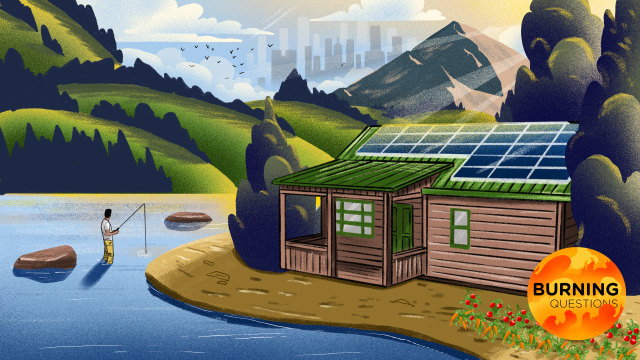Welcome to Burning Questions, a series where Earther answers the most common asks we get on how to address climate change. Many people want to do something, anything to help address the climate crisis. We answer your questions about how to help change your life — and the systems that will save us. Check out our past Burning Questions here.
Conjure up an image of someone who’s living sustainably, and you might imagine a homesteading hippie who left an urban area behind.
Maybe that sounds appealing to you, a foolproof way to lower your carbon footprint and stress levels. So if you’ve thought about leaving it all behind and going off the grid, I don’t blame you. But is living off the land actually helpful to the planet?
Living Off The Land
There are different kinds of off-grid living. There’s the complete version, wherein you forage for everything you eat and have no electricity and running water. Romantic, yes. But likely not for most people. A slightly more accessible version of off-the-land living is one where you outfit your home with solar panels and running water, grow your own food, and generally try to sparingly use other resources. This lifestyle looks dreamy in Youtube videos where beardy men live in gorgeous cabins or A-frames. But how climate-friendly all this depends on scale.
“Someone could build an off-the-grid mansion and still consume a ton of resources, so it could be more about lifestyle than being on the grid or off the grid,” Michael Sell of the Saint Francis University Institute for Energy, said.
Using a wood stove, having to drive to the store or work (you’d still need to make money, right?), and other factors would increase footprint. Wood stoves, for example, can be more damaging to the climate than fossil fuels. Growing your own food would cut down on emissions tied with transporting it from elsewhere, but it’s unlikely you’d be able to grow everything you need and if you had to resort to groundwater pumping, that could be yet another source of carbon emissions. Still, people who live in tiny houses with rainwater collection systems, compost toilets, and solar panels can “probably lower their carbon footprint,” Sell said.
But don’t write off the city lifestyle as a more climate-friendly option. Despite cultural associations of sustainability with hippie life in forested communes, living in a city can be sustainable. For one, it’s easier to efficiently power society when people live closer together. Energy transmission over long distances can be wasteful, as can driving to work or the store.
“In urban areas, populations are concentrated,” Sharon George, senior lecturer in environmental sustainability and green technology at Keele University in England, wrote in an email. “This makes management and distribution of energy and resources cheaper, and more efficient, with less associated emissions.”
There are other issues tied with where food and other resources come from that can up cities’ carbon footprints. The United Nations has found that cities use 78% of the world’s energy and produce more than 60% of global greenhouse gas emissions even though they account for less than 2% of the Earth’s surface. But at the individual level, research indicates the average city dweller has a smaller footprint than those who live in rural areas. (Let’s not get started on the suburbs.) While you could certainly live more lightly than the average forest denizen, that could come at a hefty cost most people don’t have the upfront cash to afford. And you’d also be one of an increasingly dwindling population, meaning there are diminishing returns for the climate.
Electrifying Everything in Cities Will Pay the Most Dividends
Cities are home to an increasing percentage of the world’s population. Living off the grid in the woods may lower your personal carbon footprint and allow you to wake up to the sweet sound of birdsong. To really ensure most people are able to live a decent and carbon-free life means focusing our attention on how to help cities increase energy efficiency, reduce car dependency even further, and otherwise find ways to get off fossil fuels.
One major avenue to doing that is eliminating driving by boosting density and access to affordable transit. A 2014 study by sociologist Daniel Aldana Cohen even found that large global cities, with a “modest blend of pro-density housing and transit policies,” could cut their emissions by a third by 2030.
“You need a lot of green, non-market housing so that everyone can afford the splendors and advantages of urban living … that’s well-planned with transit and a lot of walkability,” said Aldana Cohen.
There are other ways to make city living more comfortable and low-carbon. You can fight to eliminate gas stoves and other fossil fuel infrastructure from them. You can push elected officials to decarbonize schools and improve existing housing so buildings are more efficient and comfortable. That’s especially true for working class communities, which currently have less efficient and more polluting infrastructure.
Even if you do go off the grid, it’s still your responsibility to fight for greener cities if you don’t want your solar-powered cabin to eventually burn in a wildfire, have your well run dry, or catch a tick-borne illness.
“The solution … isn’t living off the grid — a luxury very few could achieve,” said Aldana Cohen. “The solution is urbanizing eco-socialism.”
